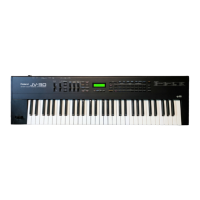Making
Full
Use
of the Multi Timbral
Features
®
Creation of the most
satisfactory Performance
Once you have
finished the recording of the
whole piece, try
listening
to
the playback. While
listening, try selecting
other Tones; and
similar
to
using
a
mixer, adjust the
overall balance by
changing
Level or Pan settings. As
finishing touches, make
adjustments for Chorus
and Reverb.
When completed, it can be
stored as a
Performance.
Once
stored as a
Performance,
a
Performance Change message
can
be
sent at the beginning
of the song, and you
W\\\
be
able to
record knowing that you
have the optimum
balance.
(5)
Changing
Tones
partway through a
song
if you make a
change in
the Tone while
recording, not only will the
sound change, but also the
Variation Number
(0
for a
Capital Tone),
Program Change Number, and Tone
Edit Data which
corresponds to
the selected
Tone will
be
transmitted.
Since
a
large
volume of data
is sent out at such
times,
you
may notice upon
listening to the
playback that the
timing of Tone
changes has shifted
somewhat. In order to
prevent such tim-
ing
problems, it is
better to first
record only the music, and
then overdub afterwards to
insert
the Tone changes.
I
Maximum
Polyphony
and Part
Priority
Ordering
[Concerning
the
Maximum
Polyphony]
The JV-30
is capable
of producing
24 voices
simultaneously.
However, when
using Tones
com-
posed
of 2 voices,
this maximum
number
of voices is reduced to
12. Also,
if using a Key
Mode,
the
maximum polyphony
will
change, since
2 Tones are played
together.
For
information on
the
number
of voices used by
particular
Tones, refer to
the "Tone
Table"
(» p.52).
[Concerning
Part
Priority
Ordering]
Note
Sounding
Priority
order
Part
number
1
10 (Drum part)
2
1
3
2
4
3
5
4
6
5
7 6
8
7
9
8
10
9
11
11
12
12
13
13
14
14
15
15
16
16
When the
number of voices
being sounded exceeds 24,
priority is given
to
producing the
most recent
sounds. Those that
have already
been
sounding
for
a
while will be
cancelled out to
make room
for the newest
notes. The JV-30
follov\^ a
priority ordering
system, whereby
the Part
hav-
ing the lowest
priority will be
the one that
has to stop
producing
sounds
first;
and thereon up
through the
order of
priority. For this
reason, you
should take a
Part's order
of priority into
consideration when
assigning it
for use
in songs.
For
sounds that you
definitely must
have
produced, use
the Voice
Reserve
function (»
p.23)
to
set an
appropriate
number of
voices for
them.
37

